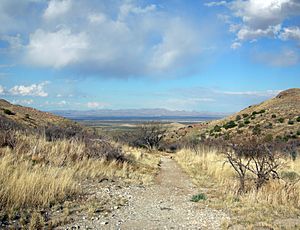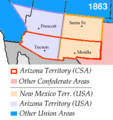Battle of Apache Pass facts for kids
Quick facts for kids Battle of Apache Pass |
|||||||
|---|---|---|---|---|---|---|---|
| Part of the Apache Wars and the Trans-Mississippi Theater of the American Civil War | |||||||
 Apache Pass |
|||||||
|
|||||||
| Belligerents | |||||||
| Apache | |||||||
| Commanders and leaders | |||||||
| Mangas Coloradas Cochise |
|||||||
| Strength | |||||||
| 116 infantry 22 cavalry 2 artillery pieces |
~200 warriors | ||||||
| Casualties and losses | |||||||
| 2 killed 3 wounded |
9 killed | ||||||
|
|||||||
The Battle of Apache Pass happened in 1862. It was fought at Apache Pass, Arizona, in the United States. This battle was between Apache warriors and Union soldiers. These soldiers were part of the California Column. They were marching from California to take over Confederate Arizona and help the Union army in New Mexico. It was one of the biggest fights between Americans and the Chiricahua Apache during the Apache Wars.
Contents
Why the Battle Happened
The California Column was a group of 2,500 Union soldiers. They traveled across the dry Southwest. They moved in smaller groups so that water sources could refill. In early 1862, Col. James Henry Carleton sent troops from Fort Yuma. Their goal was to reach Tucson, Arizona. Tucson had been taken over by Confederate soldiers.
After a small fight called the Battle of Picacho Pass, Union forces moved into Tucson. They arrived on May 20. The Confederate soldiers left without a fight because they were greatly outnumbered.
After taking Tucson, Colonel Carleton planned to march east in July. He wanted to enter New Mexico through Apache Pass. To get ready, he sent a group ahead. This group was led by Capt. Thomas L. Roberts. His group included infantry soldiers and two large guns called mountain howitzers. They also had a small group of cavalry soldiers and many wagons.
Captain Roberts needed to find out if there was enough water at Dragoon Springs. This was 28 miles further east. He led the first group with his infantry and the howitzers. Seven cavalrymen went with them as scouts. The rest of the soldiers stayed behind to guard the wagons.
Roberts found enough water at Dragoon Springs. The next day, the rest of the group joined him. They then moved towards the springs at Apache Pass in the same way.
The Battle Begins
At noon on July 15, Captain Roberts' group entered Apache Pass. They had gone about two-thirds of the way through. Suddenly, about 500 Apache warriors attacked them. The Apache leaders were Mangas Coloradas and Cochise.
The Union soldiers were in a tough spot. They had walked many miles across the hot Arizona desert. They were heading for the spring at Apache Pass. But now, the Apache warriors blocked their way to the water. Roberts knew that retreating without water could cause many of his men to die. So, he decided to fight.
The Apaches had built stone walls for defense. They also surprised the soldiers with an ambush. They waited until the soldiers were very close before firing. Apache warriors hid behind almost every tree and rock. At first, the Union troops could barely see their attackers. After a few minutes of heavy fighting, Roberts ordered his men to pull back. They regrouped at the entrance of Apache Pass. Then, they got their howitzers ready to attack the Apaches.
Fighting with Howitzers
This battle was one of the first times the United States Army used artillery against Native Americans in the Southwest. Roberts told his infantry to take the hills around the pass. He stayed in the pass to direct the howitzers. The soldiers moved forward. They found cover in an old stage station building. The soldiers were now about 600 yards from the spring. Two hills overlooked the spring, one to the east and one to the south. Apache riflemen behind stone walls on these hills fired heavily at the soldiers.
Roberts moved his howitzers forward and began firing. At first, they were too far below the Apache defenses to be very effective. Roberts moved his guns closer, even while under heavy fire. Once the guns were in good range, the artillery fired strongly. The Apaches held their positions until nightfall. Then, they left, allowing the Union troops to reach the spring. After his tired men ate, Roberts went back to bring up the rest of his group. The next morning, the Apaches returned. But they left again once the howitzers started firing.
After the Battle
Two of Captain Roberts' men were killed in the battle. Three others were wounded. Colonel Carleton reported that about 10 Apaches were killed.
Captain Cremony, another officer, spoke with an Apache who was in the battle. This Apache said that 63 warriors were killed by the artillery. Only three died from small guns. The Apache called the howitzers "wagons" because they were on wheels. They were not familiar with these types of weapons. Mangas Coloradas, one of the Apache leaders, was shot in the chest during the fight.
Colonel Carleton decided that a military post was needed at Apache Pass. This would stop settlers from being ambushed there. On August 4, the first California Column units reached Mesilla, New Mexico. At the same time, the last Confederate soldiers left for Texas.
The 5th Regiment California Volunteer Infantry was ordered to build a fort in Apache Pass. They named it Fort Bowie after their colonel, George Washington Bowie. Carleton was put in charge of the Union's Department of New Mexico. He continued to fight against the Apaches in that area.
Today, the battlefield and fort are part of Fort Bowie National Historic Site. The battle was shown in the 1952 movie The Battle at Apache Pass, though not completely accurately.
Images for kids


